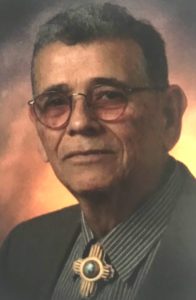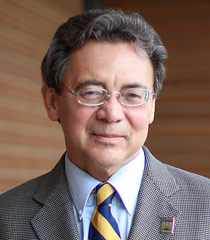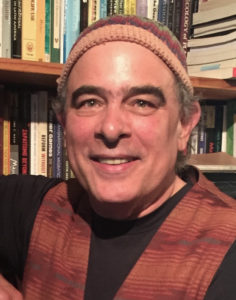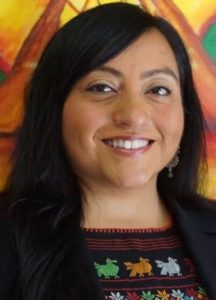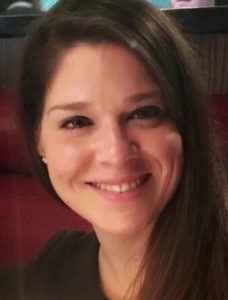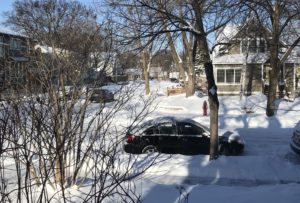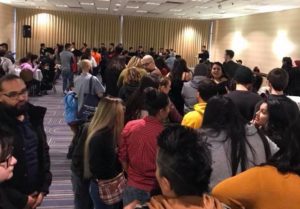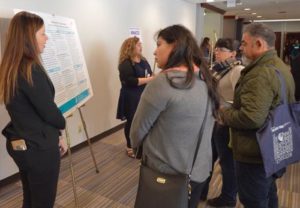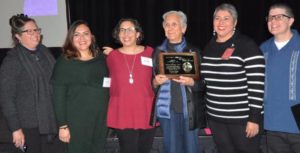NACXS 1993: Queer Chicanas on the Move
Karleen Pendleton Jiménez, Chair Elect
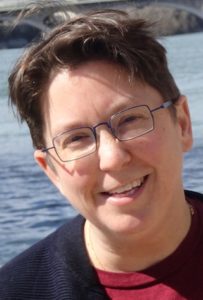
Karleen Pendleton Jiménez, Chair-Elect
Nineteen Ninety-two was my first NACXS, but 1993 is when I got hooked. In the months leading up to the conference on early morning Saturdays, I’d hop into the back of Prof. Curry’s car in Albany. She’d throw me a warm foil wrapped burrito and she and Kathy would drive and talk sociology and literature to me before my brain was working; it still felt like I was getting smarter hearing it though. We’d arrive at San Jose State into a room full of older guys who were part of the conference organizing committee.
I was the queer rep for the San Jose site committee and I felt young and intimidated surrounded by these established straight scholars. I spoke up a couple of times. I fought to have a bright pink queer tip sheet included in everyone’s folders, with local queer friendly hang-outs and resources listed. I got us a queer greeting table too. Both seemed like a huge deal.
For their part, when it came to deciding on a major speaker, they seemed torn between Anzaldua and Moraga. At the time I thought, “wow, the lesbians aren’t in the room, but they’re the biggest stars these guys could think of.” We’ve made some ground.
At the conference itself, I presented my first ever paper, “New Languages of Love Entre Chicanas” and Yvonne Yarbro-Bejarano was in the audience and I was floored. We also packed a room with a dyke fashion show panel with an mc, music, outfits, and awards, including Deb Vargas, Sandra Soto, myself, Lisa Arellanes, Marcia Ochoa, and others. If the academy could be a room full of dykes talking, laughing, theorizing, and dancing, then I thought I could be part of it.
Later that night, we chose a queer club off the list to celebrate, and danced til closing. Arriving back at the hotel around 3 am, one of the women in our group was punched by a young straight male NACXS participant. We hurried to get hotel security, but they turned on us, deciding that we were too young to be out this late. We called members of the coordinating committee, but they weren’t interested in assisting us either. Finally, I called Prof. Curry from my foco. She called others and finally got Kathy to come down. They stayed with us to meet the police and to submit our report.
The next day, we went to the Lesbian Caucus [now known as the LMBT Caucus] to tell them what happened and to ask for some kind of support. Rusty was leading the group, full of concern and outrage, and she brought us to stand together in a long line at the front of the next plenary. We condemned the violence, and asked NACXS members to take seriously the danger of homophobia, my friend’s wounded queer body an example of the consequences. I felt the shock of the room, and their warmth. They were appalled that we had been hurt.
NACXS 1993, for me, was queer Chicana celebration, vulnerability, and solidarity with our membership.
First Recollections
Ernesto Colín, Treasurer-Elect
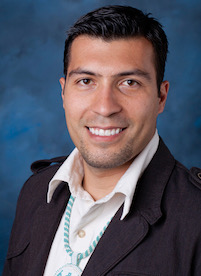
Ernesto Collin, Treasurer
My first recollections of NACCS are hazy, but the impact has been long-lasting. I attended high school in San José, CA and, as a first-generation high school student within an all-boys private school, I found a safe and generative space in a school-club called La Raza Unida. There, I developed my Xicano identity and learned about Chicanx art, literature, history, and activism. My world opened up substantially in those formative years. We had mentors from MEChA at San José State University who invited us to community events in those days: I remember marching with the UFW, a Francisco X. Alarcón Snake Poems reading, and going to an American Me film screening/discussion. Meanwhile, the NACCS conference came to San José (1993). I was in school during the week, but did make it to the conference for a bit on Saturday. I remember walking around the hotel, dazzled by the number of students and scholars who looked like me and who presented on topics excluded from my entire schooling career. I felt invigorated, thirsty for more. I didn’t not know it at the time, but in the rooms and halls of the Fairmont hotel were future professors, colleagues, scholars, and artists who I would read, admire, and who would leave an imprint on my life and scholarship.
Sustained by the ethnic studies we carved out for ourselves in high school, I chose Chicana/o Studies as one of my college majors. I kept attending MEChA statewide conferences and other academic meetings. This propelled me to graduate school and soon I was presenting and taking part in NACCS regularly (Guadalajara, Seattle, Pasadena, Chicago, SLC, San Francisco, etc.) Completing a circle perhaps, I presented in San José in 2007. I came into leadership in the organization, took my own students, helped hold space for ceremony and elders, and established professional relationships that supported my work and path to university tenure. I have appreciated the friendships, the evolutions, and the frictions within the organization. I am gratified to be a part of the fabric of the organization.
Home Coming
Francisco Villegas, At-large Representative
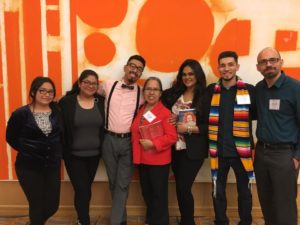
Villegas (right side) with his students and Prof. Josie Mendez-Negrete (center). NACCS Irvine, 2004.
While I have been part of NACCS since 2004, I was unable to attend a national meeting until thirteen years later. I would often hear about the different conference from friends and colleagues and look forward to being able to attend. When I finally had my opportunity two years ago in Irvine, I loved it. I brought six of my students and everyone was incredibly kind and generous to us. It was a sense of coming home and everyone welcomed us as family. We were so impressed that this year, with it being held in the Midwest, we brought 17, ten of whom shared their work. My students had never seen so many people in academia that looked like them, talked like them, and came from communities like theirs. They had also not experienced the type of spaces that valued our ontologies and epistemologies. It not only made it look possible for them to reach that space, but also to do so without selling out to hegemonic ideas about our communities. In this way, NACCS has been an important space for me to develop a sense of home within academia and to find work that is relevant to my community. Having spent so much time away, it has been a great experience to find connections to my own roots and I appreciate the opportunity to play a bigger role in the organization.
First Time
Maria C. Gonzalez, At-large Representative
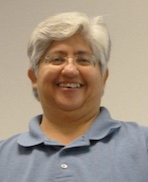
Maria Gonzalez, At-Large Rep.
Editor’s Note: Although this is not the first time Maria is part of the NACCS Board, as she has held several posts as a caucus chair, a foco representative and as an At-large representative (until 2017). So she did leave us for a short time and was reappointed when an At-large rep resigned mid-term from his post. We are pleased that she was elected/reelected by the membership.
The first NACCS I ever attended was in San Antonio in 1992 when NACCS was NACS – National Association for Chicano Studies. With or without “Chicanas” in the name, it has always been welcoming conference. I was a newly minted Ph.D. out of a large Midwestern University with very little direct connections to NACS. I only knew the names of presenters through reading their books and articles. Today, I consider many of its longtime members good friends. And while I have seen my share of the struggles within the organization, I can say I would rather be at any NACCS conference than to ever have to attend another MLA meeting again.
Lilia Soto, Secretary
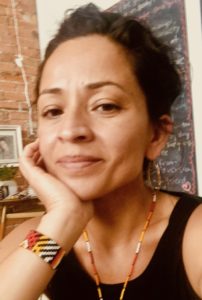
Lilia Soto, Secretary
My first NACCS experience was in 2003 Los Angeles. I presented with my fellow Ethnic Studies classmates from UC Berkeley in 2004, Albuquerque. But it took me, to take my students to the 2015 NACCS meeting in San Francisco to remind me how I felt attending NACCS as a student. My colleague and I took four students from the Latina/o Studies Program at the University of Wyoming, who had been accepted to present their research. The title of the panel, “The Neglect of Mexican Immigrants in the Equality State,” included papers by four of our brightest undergraduates who were interested in exploring the meaning of being Chicana/o in a state like Wyoming where the majority of the population does not look like them. They were interested in exploring migration in a non-gate state that everyone seems to forget. I had the pleasure and privilege of working with these students from the initial stages: putting the proposal together, completing their papers, and rehearsing their papers out loud. For all of them, this was their first NACCS. The panel was well attended and the audience was quite interested in understanding what it meant to be Chicana/o in a state like Wyoming, when and how they arrived, how they survive, and what they hoped to pursue upon graduation. As someone from California who grew up surrounded by Chicana/o/Latinx communities who moved to Laramie, I have become used to such questions. For the students, however, this was new, which made their lived experiences and research projects all the more special and important as the audience was receiving first-hand accounts of life beyond the Southwest.
Upon returning home, we debriefed. The students spoke to what it felt like to be surrounded by so many people who looked like them, by scholars whom they had read, and overall by the collegiality and camaraderie they received. Friendships were forged. Attending NACCS allowed our students to ponder on pursuing M.A. and Ph.D. degrees and return to their state and make changes at various levels. Sometimes we forget what such intellectual spaces mean. It is wonderful to be reminded and I thank my students for reminding me of how I felt attending my first NACCS back in 2003.

